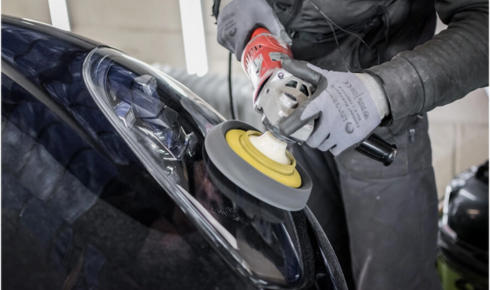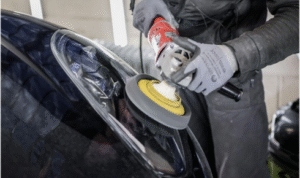
car headlight protection
The contemporary automotive design landscape places enormous emphasis on headlight technology. Beyond their fundamental role in illumination, modern headlamps—from adaptive matrix LED clusters to complex Xenon arrays—are signature aesthetic features, costing thousands of pounds to replace. Yet, ironically, these high-tech components are often the most neglected parts of a vehicle’s exterior, left vulnerable to the relentless assault of road grit, UV radiation, and environmental pollutants.
A degraded headlight assembly is not merely an eyesore; it is a critical safety hazard and a silent killer of a vehicle’s resale value. The team at Tintex has identified this vulnerability, turning it into a core specialism. Their philosophy treats the headlamp lens not as a disposable part, but as a long-term optical instrument deserving of a specialised maintenance and preservation protocol. This protocol is split into two distinct, yet complementary, services: proactive car headlight protection and expert car headlight restoration.
Why Modern Lenses Need Car Headlight Protection
For new or perfectly restored vehicles, the strategy is purely preventive. The polycarbonate lenses used in virtually all modern vehicles are lightweight and shatter-resistant, but they have a fatal flaw: they are highly susceptible to oxidation when their thin, factory-applied UV coating fails. This failure is accelerated by constant exposure to harsh sunlight and thermal cycling, leading to the familiar, unsightly yellowing and hazing.
The Tintex solution for pre-emptive care is the application of a bespoke car headlight protection film. This is a highly engineered, optically clear version of Paint Protection Film (PPF), specifically designed for curved and complex lens surfaces.
This film is far superior to cheap, generic vinyl covers. It is a thick (typically 8 mil or more), durable polyurethane layer that serves multiple, critical functions:
- UV Barrier: It acts as a powerful, permanent sacrificial layer, blocking over 99% of harmful ultraviolet radiation, thus preventing the degradation of the underlying factory polycarbonate. This is the single most important long-term benefit.
- Kinetic Defence: It absorbs the energy from stone chips, sandblasting, and minor impacts, preventing pitting, cracking, and surface abrasion—the very damage that compromises light output and necessitates replacement.
- Self-Healing Properties: The highest-grade films, preferred by Tintex, possess a thermoplastic polymer structure that allows fine scratches and swirl marks (often inflicted by improper cleaning) to literally disappear when exposed to heat, maintaining perfect clarity indefinitely.
The installation of car headlight protection at Tintex is a specialised process. Headlights have complex curves and vents, making bubble-free and seamless installation exceptionally challenging. Their technicians use advanced software to custom-cut the film to the exact geometry of the lamp, then employ heat-forming techniques to ensure the material stretches perfectly over the complex curves, wrapping slightly around the edges where possible. The resulting finish is so seamless and optically clear that the film is invisible, yet it provides a defence unparalleled by any chemical spray or liquid coating.
The Art of Car Headlight Restoration
What happens when a vehicle arrives at Tintex already suffering from years of neglect? The lenses are opaque, yellowed, and heavily pitted. In these cases, proactive protection is too late; a full car headlight restoration service is required.
The typical, over-the-counter restoration kit is often a temporary solution, relying on an abrasive pad and a simple wipe-on polymer that offers minimal UV protection and quickly fails. Tintex approaches restoration with a multi-stage, systematic process that aims to achieve a finish indistinguishable from a new lens, not just a temporary clean-up.
The process is meticulously documented and executed:
- Diagnosis and Isolation: The surrounding bodywork is masked off with precision to prevent any damage to the paintwork or trim from the aggressive sanding required.
- Progressive Refinement (Sanding): The technician starts with a coarse grit (often as low as 400-600 grit) to cut through the heavily oxidized, damaged layer and deep pitting. This is the critical, irreversible step. The key is progressive refinement: moving through a series of increasingly finer grits (e.g., 800, 1000, 1500, 2000, 3000) using a specialised orbital sander and wet sanding techniques. The final sanding stage must leave a perfectly uniform, microscopically smooth surface, ready for polishing.
- High-Definition Polishing: The sanded lens is then polished using multiple stages of specialist compounds and foam pads. This removes the final sanding marks and brings the lens to a state of optical clarity and high gloss that is paramount for light transmission.
- Sealing for Longevity: A fully restored lens, while clear, is now unprotected—the factory UV coating is gone. A crucial step that differentiates a professional service from a DIY fix is the final sealing. Tintex technicians will typically apply either a dedicated UV-inhibiting coating or, better yet, proceed to apply a clear, durable Car headlight protection film. Without this final, professional-grade UV barrier, the lens will inevitably re-haze within a year or two.
The effectiveness of this meticulous car headlight restoration cannot be overstated. By returning the lens to its original, perfect clarity, the technician ensures the vehicle’s beam pattern is restored to its intended design specification, eliminating dangerous light scattering and maximizing the usable light on the road.
Safety, Aesthetics, and Investment
For Tintex’s clientele, the integrity of their headlights is not a trivial concern. From a performance perspective, compromised light output is directly linked to increased driver fatigue and delayed hazard recognition, especially during the darker, longer UK winters. From an aesthetic perspective, foggy headlights can make an otherwise pristine vehicle look tired and neglected, immediately knocking down its perceived value.
By integrating the proactive strategy of car headlight protection for new vehicles and the restorative expertise of car headlight restoration for older ones, Tintex offers a complete optical solution. They understand that a vehicle is a complex system of intertwined components, and protecting the optics is just as important as protecting the paintwork.
In a market saturated with quick-fix solutions and temporary waxes, Tintex provides a definitive, long-term assurance of optical integrity. It is the commitment to this detail—the understanding that a component the size of a hand can profoundly impacts the value, safety, and look of a multi-thousand-pound machine—that cements their reputation as leaders in automotive preservation. They don’t just restore clarity; they restore confidence and guarantee performance.







